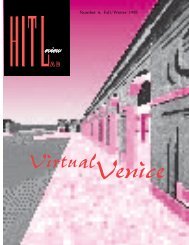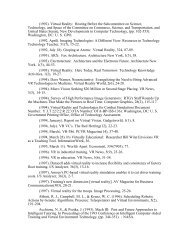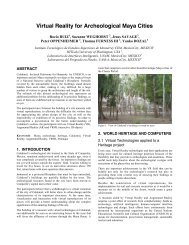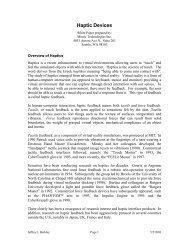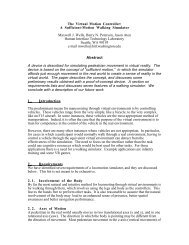A Calculus of Number Based on Spatial Forms - University of ...
A Calculus of Number Based on Spatial Forms - University of ...
A Calculus of Number Based on Spatial Forms - University of ...
Create successful ePaper yourself
Turn your PDF publications into a flip-book with our unique Google optimized e-Paper software.
61<br />
mulas specify how they transform: some functi<strong>on</strong>s have several representati<strong>on</strong>s while<br />
others are unique and some combinati<strong>on</strong>s can be simplied while others cannot. Because<br />
the visual form does not c<strong>on</strong>vey these relati<strong>on</strong>ships, much external knowledge<br />
must be brought to the task <str<strong>on</strong>g>of</str<strong>on</strong>g> doing mathematics.<br />
In this way, standard notati<strong>on</strong> fails to support learning mathematics. Availability<br />
and applicati<strong>on</strong> <str<strong>on</strong>g>of</str<strong>on</strong>g> rules are not suggested by the forms. Knowledge <str<strong>on</strong>g>of</str<strong>on</strong>g> these<br />
rules remains distinct and separate from this mathematical interface. Dissociating<br />
knowledge from appearance leaves an impressi<strong>on</strong> that the knowledge is arbitrary and<br />
without foundati<strong>on</strong>. Only by accepting this knowledge <strong>on</strong> faith can a student bypass<br />
the c<strong>on</strong>tradicti<strong>on</strong>s <str<strong>on</strong>g>of</str<strong>on</strong>g> form introduced by this dissociati<strong>on</strong>.<br />
The failure to instantiate mathematical knowledge in its visual forms further c<strong>on</strong>tributes<br />
to the misc<strong>on</strong>cepti<strong>on</strong> that mathematics is a purely cognitive activity. In<br />
doing so, mathematical ability is politely restricted to <strong>on</strong>ly the \gifted" populati<strong>on</strong>,<br />
another failure <str<strong>on</strong>g>of</str<strong>on</strong>g> mathematics educati<strong>on</strong>.<br />
The boundary calculus can impact mathematics educati<strong>on</strong>. It provides another<br />
reference for the implementati<strong>on</strong> <str<strong>on</strong>g>of</str<strong>on</strong>g> formal mathematical c<strong>on</strong>cepts and arguably presents<br />
a better interface to mathematical behavior.<br />
8.6 C<strong>on</strong>clusi<strong>on</strong>s<br />
The stages <str<strong>on</strong>g>of</str<strong>on</strong>g> mathematical representati<strong>on</strong> can be readdressed under the paradigm <str<strong>on</strong>g>of</str<strong>on</strong>g><br />
boundary mathematics so that the activities <str<strong>on</strong>g>of</str<strong>on</strong>g> mathematics are more clearly delineated.<br />
The boundary calculus isolates manipulative c<strong>on</strong>straints, leaving c<strong>on</strong>ceptual<br />
objects as c<strong>on</strong>structi<strong>on</strong>s <str<strong>on</strong>g>of</str<strong>on</strong>g> the boundary forms. The delineati<strong>on</strong> gives those particular<br />
c<strong>on</strong>structi<strong>on</strong>s meaning and benet that is usually hidden. Standard choices for<br />
organizing numbers are actually optimized for certain criteria. Opening up representati<strong>on</strong><br />
with the boundary calculus makes the criteria <str<strong>on</strong>g>of</str<strong>on</strong>g> representati<strong>on</strong> and the<br />
choices <str<strong>on</strong>g>of</str<strong>on</strong>g> structure more explicit.



